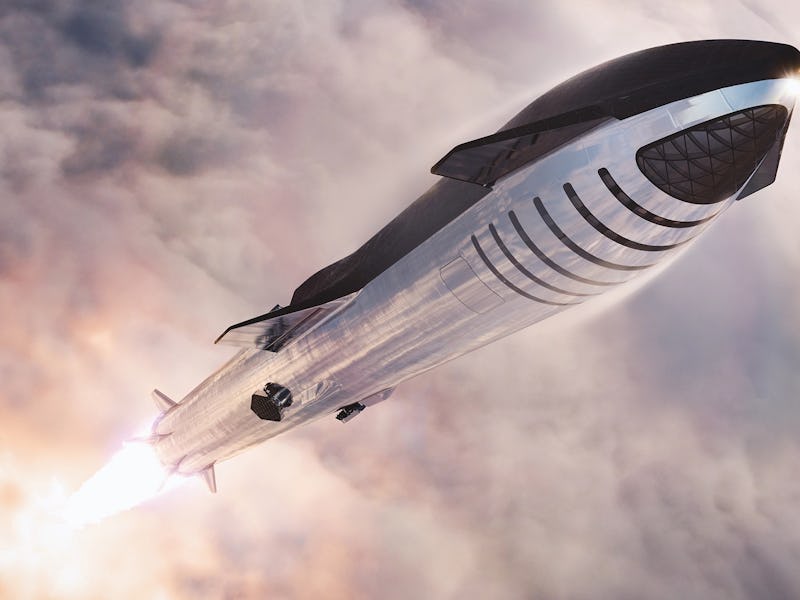New ocean spaceport reveals SpaceX's next chapter
Elon Musk plans to unveil a spaceport in the ocean. Here's what you need to know.

SpaceX plans to set up a spaceport in the ocean — one that could enable trips to Mars and beyond.
On May 30, SpaceX CEO Elon Musk confirmed via Twitter that the company is currently building its Deimos ocean-based spaceport, with a view to launching in 2022. Musk announced the news by sharing a fanmade render of the spaceport from 3D artist Kendall Dirks.
Want to find out more about SpaceX’s plans for Starship? Subscribe to MUSK READS+ for exclusive interviews and analysis about spaceflight, electric cars, and more.
Musk’s Twitter post.
It’s an exciting next step in SpaceX’s plans for Starship. When its predecessor was first unveiled in September 2017, Musk explained that it was a fully-reusable ship designed to take on satellite launches for the likes of Falcon 9 and Falcon Heavy, while also enabling new missions like sending humans to Mars.
The ocean-based spaceports will help make these goals a reality. In June 2020, Musk wrote that “SpaceX is building floating, superheavy-class spaceports for Mars, moon & hypersonic travel around Earth.” In August 2020, Musk claimed the ship would “mostly launch” from the ports “long-term.”
SpaceX Starship: what do we know about ocean spaceports?
There are two known SpaceX Starship ocean spaceports:
- Deimos, the rig Musk mentioned last month.
- Phobos, a near-identical companion port.
The ports, perhaps rather aptly, are named after the moons of Mars.
Reporter Michael Baylor revealed the firm had ties to two oil rigs under the same name in January. The rigs will be retrofit into the new at-sea platform for both launch and landing.
Ownership was transferred in September 2020 to a firm called Lone Star Mineral Development LLC. The firm was incorporated just before the rigs transferred ownership. An eagle-eyed reader revealed that the mysterious company has only one principal on record: Bret Johnson, SpaceX’s chief financial officer and president of the strategic acquisitions group.
Before their purchase, they were known by the names ENSCO 8500 and ENSCO 8501. Both were previously owned by Houston-based offshore drilling contractor Valaris, who at the time was filing for bankruptcy. SpaceX purchased the rigs at a cost of $3.5 million each.
The ENSCO 8500 series of rigs have a main deck that measures 240 feet wide and 255 feet long. For reference, the Starship will measure around 30 feet in diameter. When paired with the Super Heavy booster, the Starship will measure around 400 feet tall.
SpaceX plans a number of missions for the Starship, including lunar landings.
SpaceX Starship: how will the ports work in practice?
Musk has explained, through a series of Twitter posts, how operations will work.
In November 2019, he explained that the ships would be placed around the world approximately 20 miles away from the shore. This is to ensure the roaring sound of the rocket won’t disturb nearby cities. SpaceX aims to host point-to-point flights around the Earth to help pay for the Starship.
In February 2021, he noted that the ships will fly to the spaceports from SpaceX’s launch site. This is presumably “Starbase,” the South Texas launch site and emerging community that Musk expects to “grow by several thousand people over the next year or two.”
The Starship uses liquid oxygen and methane as its fuel. In the short term, the rigs are expected to receive deliveries of fuel ahead of the ship flights. But in the long term, Musk wants the ships to convert carbon dioxide and water into new fuel, using the same processes expected to play a role in Mars missions. The process will enable Mars visitors to refuel and return home. The rigs could prove the viability of such a plan.
SpaceX's plans for creating more fuel.
SpaceX Starship: when will the spaceports host flights?
Musk claimed last month that the spaceport will be ready by next year. If SpaceX fulfills its goal of hosting an orbital flight this year, it’s possible that the spaceport could host a test flight as early as next year.
The firm is aiming to host some non-test Starship missions as early as 2023, like Japanese billionaire Yusaku Maezawa’s trip around the moon. If all goes well, SpaceX may start hosting its ocean-based flights in just two years’ time.
THE STARSHIP’S JOURNEY, SUMMARIZED:
- November 2018 — BFR, first announced in September 2017, gets renamed to Starship.
- December 2018 — Musk confirms the new ship has switched to stainless steel.
- January 2019 — Shortened “Starhopper” prototype unveiled and Musk explains the switch to steel.
- February 2019 — Raptor engine beats a long-standing rocket record.
- April 2019 — Starhopper completes a tethered “hop.”
- July 2019 — Starhopper launches 20 meters (67 feet).
- August 2019 — Starhopper launches 150 meters (500 feet).
- September 2019 — Starship Mk.1 full-size prototype unveiled.
- May 2020 — Starship SN4 full-size prototype completes a static test fire.
- August 2020 — SN5 launches 150 meters (500 feet).
- October 2020 — SN8 completes the first triple-Raptor static fire.
- December 2020 — SN8 launches 12.5 kilometers (41,000 feet) and crashes into the ground.
- February 2021 — SN9 launches 10 kilometers (33,000 feet) and crashes into the ground.
- March 2021 — SN10 launches 10 kilometers (33,000 feet), lands, and explodes eight minutes later. That same month, SN11 launches 10 kilometers (33,000 feet) and hits the ground in several pieces.
- May 2021 — SN15 launches 10 kilometers (33,000 feet) and lands without a hitch, except for a small fire at the base.
SUBSCRIBE TO MUSK READS+, A PREMIUM NEWSLETTER THAT COVERS THE WORLDS OF ELON MUSK, SPACEX, TESLA, AND EVERYTHING BETWEEN.
This article was originally published on